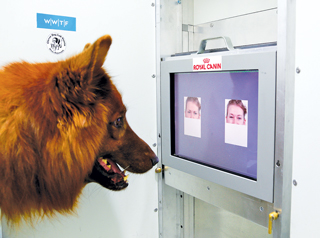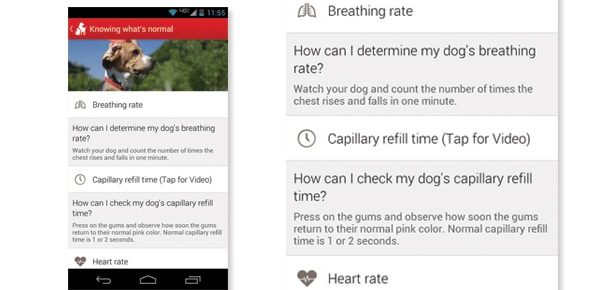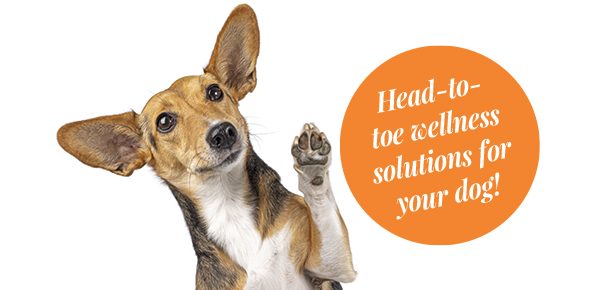

Dogs Can Read That Smile On Your Face
A new study shows dogs can recognize emotions simply by looking at a human face
When you and I look at a photograph of a human face, we can easily recognize the emotional state of the person pictured by their expression alone. Fascinatingly, it turns out, dogs can do the same.
Several years ago I visited the laboratory of a colleague, a well-known researcher in the area of human emotions. He was putting together a display for an exhibition and had prepared several oversized photographs of one person showing a variety of emotional expressions. The photos were resting on the floor, propped up against the wall so that he could select the ones that he wanted. I had my young Beagle, Darby, with me and, in the way that dogs do, Darby walked along the line of pictures sniffing and glancing at each–that was, until he reached the one showing an angry expression, at which point he stopped, looked at the photo and then backed away and did not approach it again. I wondered whether Darby was reading the emotion in that angry expression and thus avoiding the picture, but there was no data at that time showing dogs possessed the degree of sensitivity needed to read emotions solely based on the expression shown by a human face. Since then, however, researchers have found that dogs are indeed capable of discriminating emotion from photographs of faces alone. A new study offers very interesting further proof.

a fairly subtle level of interpretation, however, new research shows dogs capable of exactly that.
The new study that has been accepted for publication in the journal Current Biology set out to determine whether dogs are able to read human emotions just by looking at a person’s face. The team of researchers was headed by Corsin Müller from the Messerli Research Institute at the University of Veterinary Medicine in Vienna. The investigators trained a group of 11 dogs to distinguish between images of the same person making either a happy or an angry face. The first thing to note is that the dogs did not get to see the full face. Each dog was shown only the upper half or the lower half of the person’s face. For each dog, one expression, happy or angry, was chosen to be the correct one, and the dog had to indicate that face by using their nose to touch a picture of it shown on a computer display screen. Faces were shown in pairs and tapping the correct face gave the dog a food reward.
Now some of you are probably thinking that the fact that dogs could learn this discrimination does not mean that dogs automatically read and interpret the emotional expressions of people, but rather that they can be taught this skill. However, the test phase of the experiment goes much further. The most interesting finding comes after the training phase during which the dogs had proven that they could distinguish between happiness and anger when merely allowed to see only the upper or lower half of the face. In the subsequent testing segment of the study, the dogs were shown either the other half of the face used in the training stage, or halves of unfamiliar faces; the dogs could still discriminate between the happy and angry expressions.
Müller summarizes his conclusions by saying “Our results suggest that the successful dogs realized that a smiling mouth means the same thing as smiling eyes.” Furthermore he suggests that the dogs’ ability to thus read human facial expression is based on their prior knowledge of the meaning of human emotional expressions, stating, “We think the dogs in our study could have solved the task only by applying their knowledge of emotional expressions in humans to the unfamiliar pictures we presented to them.”
Ludwig Huber, a senior author on the research team, added some additional interpretation: “Our study demonstrates that dogs can distinguish angry and happy expressions in humans. They can tell that these two expressions have different meanings, and they can do this, not only for people they know well, but even for faces that they have never seen before.” What exactly those different meanings are for the dogs is not directly addressed by the study; however, Huber suggests that “it appears likely to us that the dogs associate a smiling face with a positive meaning and an angry facial expression with a negative meaning.”
What is particularly interesting to me in reviewing this new set of data is that the researchers report that the dogs were much slower to learn to associate an angry face with a reward during the training portion of the study. This certainly seems to suggest that the dogs already had an idea, based on prior experience, that it’s best to stay away from people when they look angry. This means that asking them to approach and touch the angry face in order to get a reward conflicts with their natural avoidance tendencies. All of this brings me back to my young Beagle who looked at the photograph of an angry face which was propped up on the floor, seemed to read its expression, and decided that that was one photo he really didn’t want to be near. He seemed to understand that good things happen to dogs when they are near a human with a happy face while bad things happen to dogs when they are near a person with an angry expression. It’s something to remember. As the expression goes, you catch more flies with honey.
Join the newsletter and never miss out on dog content again!
"*" indicates required fields
By clicking the arrow, you agree to our web Terms of Use and Privacy & Cookie Policy. Easy unsubscribe links are provided in every email.





